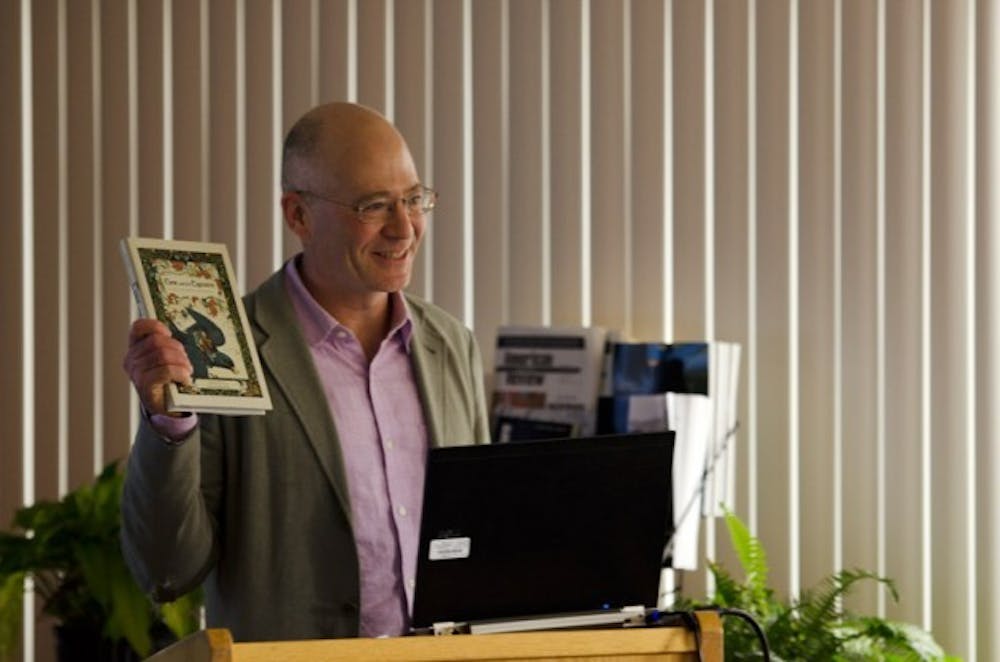After several technological blunders almost kept Dr. John Plotz from the podium, he stepped up to head a Clemens classroom Friday, ready to delve into his work on silent films.
Students’ pencils began to scrape along their notebooks, fingers tapped on MacBook keys and eyes were focused on Plotz’s presentation.
Plotz, an English professor and published author from Brandeis University, gave a lecture exploring the characterization of partial absorption within film experiences focusing on performer Buster Keaton’s art.
Keaton was an American actor, writer, comedian and former vaudevillian who reached the peak of his career during the silent film era of the 1920s. The actor is best known for his physical comedy, featuring a detached facial expression, which became commonly known as “The Great Stone Face” – an attribute Plotz discussed in detail.
Plotz’s analysis was about the aesthetics of Keaton’s acting as he managed to travel in and out of his own world in films. Film clips complemented the lecture and demonstrated Keaton’s work.
The first clip was from the 1925 film, Seven Chances. Keaton’s shy character fantasizes about and rehearses a marriage proposal. The audience can see Keaton practicing the proposal, without the actor realizing his love was behind him the entire scene. To Keaton’s surprise, the girl says yes causing him to sync back into the reality of the situation.
The professor said this particular scene speaks directly to the film’s audience and our understanding of the world around us. Plotz focused on Keaton’s ability to exploit and be semi-detached to every possibility in his surroundings with his face’s blankness also engaging the audience.
“This lecture is a real departure for me, it’s the first time I’ve talked about films ever. I usually discuss novels and a little bit about paintings,” Plotz said. “I was a bookworm as a kid and lost myself in books and films. I feel like I lived most of my teenage years in books.”
Plotz suggested Keaton is a master of exploring the art of one’s skill to be lost in his or her thoughts. Plotz highlighted Keaton’s signature “stone face” as his method of interpreting circumstances found within films. The professor described Keaton as a hexagon trying to fit unsuccessfully into a circle where the audience can properly assess his failures, as he manages to recover in the end.
Plotz discussed his theory used to define Keaton’s relative adjustment to the changing world. The professor introduced this term as a cycloid, construing it as the mathematical format of Keaton’s comprehension to be in and out of touch with reality.
“I thought it was an interesting lecture and he had a lot of early, great insights about how film functions,” said Paul Beattie, an English graduate student. “That has a lot promise by looking [at] how other types of narratives, books and other media work as well.”
The final clip shown was from the 1924 film Sherlock Junior. Keaton was also trying to propose to a girl in the film, but he wasn’t sure how. The actor began to watch a film along with the audience, where a man was proposing and followed his lead step by step.
The camera cut between Keaton’s “stone face” while watching the film, then back to him proposing to his girlfriend. When the film that cued Keaton’s steps ended, he was unsure what to do next. Plotz said the scene signifies our ability to be partially immersed into what’s offered and apart from us.
In the final part of his lecture, Plotz theorizes that Keaton explores real presence and also disembodied abstraction regardless of if it’s in life or film. The professor discussed the audience’s understanding of what it means to be captured in a dream space of film and have the capability to separate from it and bounce back.
As his lecture ended, Plotz stayed for half an hour to answer questions and critiques on his ideas.
“He did a really good job, especially answering the several rigorous questions,” said Luke Heister, an English graduate student. “There’s some references in World War I poetry with soldiers being disoriented to the world and the lecture made me think of it because of the closeness in time.”
Plotz, who specializes in novels, Victorian literature, politics and aesthetics, had a children’s novel, “Time and the Tapestry: A Williams Morris Adventure” published in July. His next creative project is writing “The Recalcitrants,” a novel about the immensely forgotten and cantankerous writers trapped in “the American century.”
Plotz’s lecture showed those in attendance that actors, like Keaton, can become just as separated from reality in making a movie as the audience does watching it, forcing them to bounce back.
“The Great Stone Face” becomes the perfect expression for suspension of disbelief.
email: arts@ubspectrum.com





